About some aspects of repairing a hard drive electronics board
Hello, dear habravchane! This is the first publication in the newly opened corporate blog of Hardmaster, specializing in professional data recovery from storage. And I am with you, leading engineer Artem Makarov aka Robin. In this blog, my colleagues and I, to the best of our ability, will try to lay out materials that can really help everyone to independently cope with the tasks of repairing failed devices and recovering information from them.
One of the common causes of hard drive failures are problems with the electronics board.
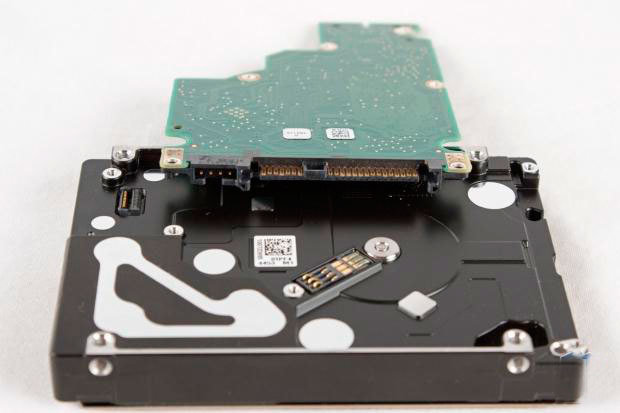
(in common it is called the HDD controller, which of course is incorrect)
')
And we begin the cycle of publications on the review of HDD board breakdowns and methods for their elimination. Subscribe and stay tuned!
Board failures can be divided into electromechanical and logical. The logical speech will come later, but the undisputed leader of the first ones are burnable protective elements in the power circuit, which is due to the so-called thyristor effect of the power supply, the situation when the upper and lower keys are turned on and off and a sharp increase in the current consumption occurs, which leads to “breakdown” of the protective elements of the hard disk, after which they either “ring” on the short circuit or go “to the open”.
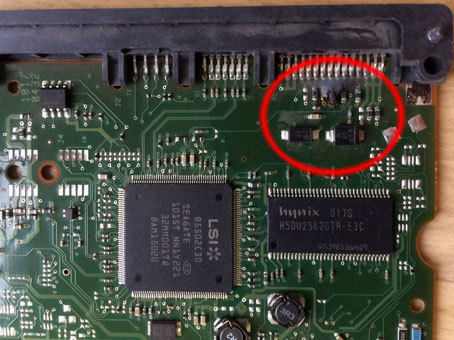

Such a fault may manifest itself as follows:
Finding the “weak link” is not difficult. Even if you have never seen one or another board, all of them are arranged according to similar principles and TVS diodes, as well as SMD protection fuses, will nest near the power connector. With the help of a multimeter, you can ring out these items and identify faulty ones.

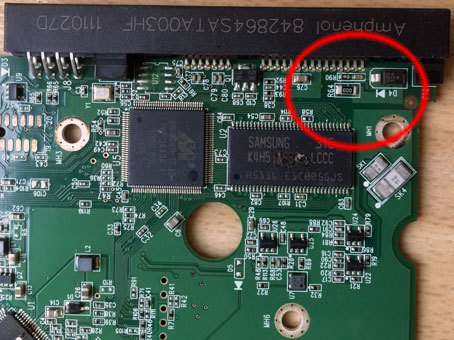
TVS-protective diodes: when an impulse hits them more than a given one, anode and cathode are sintered and the dark side of the force goes to ground.
Further, if we are talking about TVS-protective diodes, then by identifying the “burned” element it can be replaced. It is better, and in an Orthodox way, to take the same, obviously serviceable. But this possibility is not always. In our many years of practice, we follow the simple rule for this kind of replacement - take an arbitrary fee from Seagate 3.5 "7200.7-12, WD 3.5" (any SATA) or Samsung 3.5 "SATA \ IDE. Search for the desired circuit (+5 or +12 V) outwardly similar, and change to it.
In most cases, the disc will work without any of these elements! They soldered, and if the soldering iron was not at hand, they bit out with a nipper, the short circuit was eliminated and the disk started working. But! It is strongly not recommended to do this, unless the information on the disk is not important and the disk itself is not really needed. For without immunity at the entrance, when the hard drive arrives on the wiring for the next time, the consequences may be worse.
In addition, having soldered the necessary elements instead of the burned ones, before screwing the board to the HDA and supplying power, it is strongly recommended to make a dial on the "+5 - earth" and "+12 - earth" circuits, as well as carefully examine the remaining elements on the HDD board for visual traces hellish flame. Otherwise, the newly sealed parts will at least burn themselves when turned on, and as a maximum, the processor or switch in the pressure zone will burn. By the way, for additional acquaintance with the subject of publication anyone can read a brief overview of the hard disk device in order to better understand the terminology.
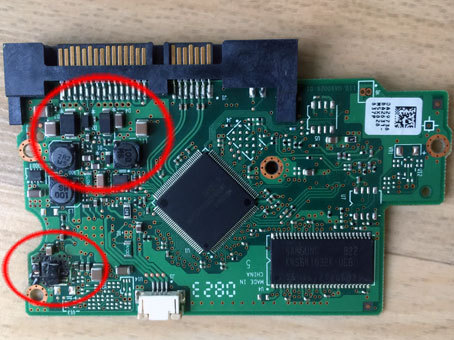
We check not only the protective diodes near the power connector (above) but also the rest of the elements.
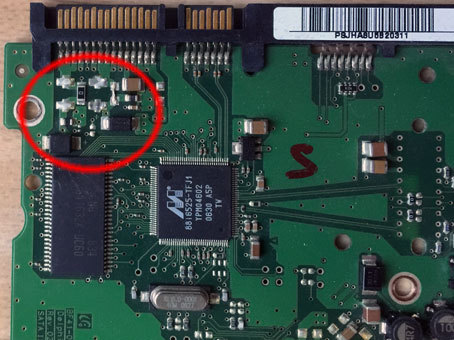
Here is an example of a Samsung HDD board, where the user decided to fix the damage by soldering the jumper and burned the processor on the PCB.
If you can start a drive without diodes at your own risk, it will not work without SMD fuses. It is possible to take a replacement from another board, and for this purpose, Westerns are perfect, there are many tasty and useful SMD small things “without GMOs” on their shawls. Most often, such protection is found on boards from 2.5-inch hard drives, so-called “notebook”:
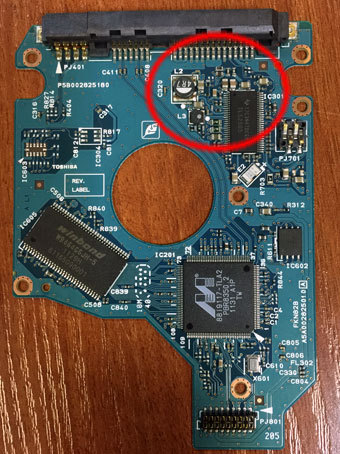
Marked security features on Toshiba HDD PCB
The next problem is the burnout of the so-called “twist”, which is also a “twist-stirrer”, which is also a preamplification \ switching circuit. Here are some examples:
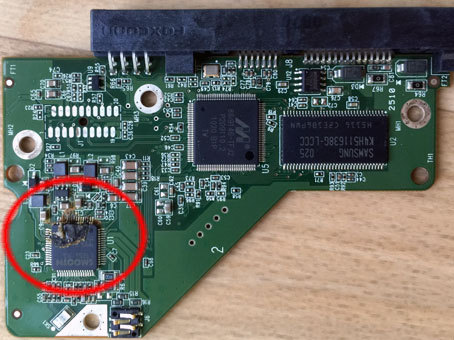

Identify the cause visually no problems. And if someone is not lucky with vision, then such a breakdown and the characteristic smell can be found. Problem pozakovyriste burned trans. To eliminate it, in some cases it is possible to solder the m / s taking from the donor disk, but often mikruha burns by igniting the conductors around itself, fusing the SMD strapping, etc.
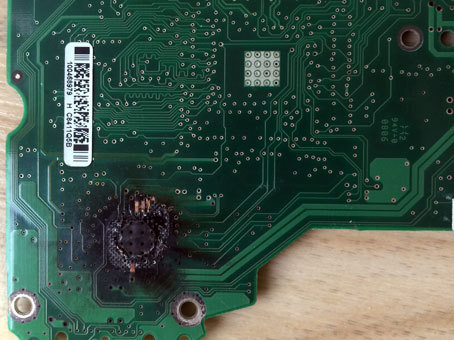
Therefore, both for repair and for pulling out an archive of photos of the beloved cat Barsik, it will be easier, and perhaps more correct, to change the electronics board entirely. How to do this, what pitfalls can be expected at this stage from different manufacturers and families, we will tell you in one of the following publications.
One of the common causes of hard drive failures are problems with the electronics board.

(in common it is called the HDD controller, which of course is incorrect)
')
And we begin the cycle of publications on the review of HDD board breakdowns and methods for their elimination. Subscribe and stay tuned!
“He said - Let's go!” (C)
Board failures can be divided into electromechanical and logical. The logical speech will come later, but the undisputed leader of the first ones are burnable protective elements in the power circuit, which is due to the so-called thyristor effect of the power supply, the situation when the upper and lower keys are turned on and off and a sharp increase in the current consumption occurs, which leads to “breakdown” of the protective elements of the hard disk, after which they either “ring” on the short circuit or go “to the open”.


Such a fault may manifest itself as follows:
- When you turn on the PC with the “burned-out” HDD connected to it, the computer does not turn on, either not responding to the power button at all, or to start briefly and then turn off. The same is true when connecting to such a disk separately power connector from an external PSU
- When power is applied to the hard disk, it shows no signs of intelligent life. The spindle engine does not rotate, and if you attach a simple human ear to the HDA, you will not hear any noise, noise, etc. And if such a disk is connected to the ATA terminal (the functionality is available in the popular diagnostic products mhdd and victoria) and supply power, then the registers will not be active.
Finding the “weak link” is not difficult. Even if you have never seen one or another board, all of them are arranged according to similar principles and TVS diodes, as well as SMD protection fuses, will nest near the power connector. With the help of a multimeter, you can ring out these items and identify faulty ones.


TVS-protective diodes: when an impulse hits them more than a given one, anode and cathode are sintered and the dark side of the force goes to ground.
Further, if we are talking about TVS-protective diodes, then by identifying the “burned” element it can be replaced. It is better, and in an Orthodox way, to take the same, obviously serviceable. But this possibility is not always. In our many years of practice, we follow the simple rule for this kind of replacement - take an arbitrary fee from Seagate 3.5 "7200.7-12, WD 3.5" (any SATA) or Samsung 3.5 "SATA \ IDE. Search for the desired circuit (+5 or +12 V) outwardly similar, and change to it.
In most cases, the disc will work without any of these elements! They soldered, and if the soldering iron was not at hand, they bit out with a nipper, the short circuit was eliminated and the disk started working. But! It is strongly not recommended to do this, unless the information on the disk is not important and the disk itself is not really needed. For without immunity at the entrance, when the hard drive arrives on the wiring for the next time, the consequences may be worse.
In addition, having soldered the necessary elements instead of the burned ones, before screwing the board to the HDA and supplying power, it is strongly recommended to make a dial on the "+5 - earth" and "+12 - earth" circuits, as well as carefully examine the remaining elements on the HDD board for visual traces hellish flame. Otherwise, the newly sealed parts will at least burn themselves when turned on, and as a maximum, the processor or switch in the pressure zone will burn. By the way, for additional acquaintance with the subject of publication anyone can read a brief overview of the hard disk device in order to better understand the terminology.

We check not only the protective diodes near the power connector (above) but also the rest of the elements.

Here is an example of a Samsung HDD board, where the user decided to fix the damage by soldering the jumper and burned the processor on the PCB.
If you can start a drive without diodes at your own risk, it will not work without SMD fuses. It is possible to take a replacement from another board, and for this purpose, Westerns are perfect, there are many tasty and useful SMD small things “without GMOs” on their shawls. Most often, such protection is found on boards from 2.5-inch hard drives, so-called “notebook”:

Marked security features on Toshiba HDD PCB
The next problem is the burnout of the so-called “twist”, which is also a “twist-stirrer”, which is also a preamplification \ switching circuit. Here are some examples:


Identify the cause visually no problems. And if someone is not lucky with vision, then such a breakdown and the characteristic smell can be found. Problem pozakovyriste burned trans. To eliminate it, in some cases it is possible to solder the m / s taking from the donor disk, but often mikruha burns by igniting the conductors around itself, fusing the SMD strapping, etc.

Therefore, both for repair and for pulling out an archive of photos of the beloved cat Barsik, it will be easier, and perhaps more correct, to change the electronics board entirely. How to do this, what pitfalls can be expected at this stage from different manufacturers and families, we will tell you in one of the following publications.
Source: https://habr.com/ru/post/251263/
All Articles